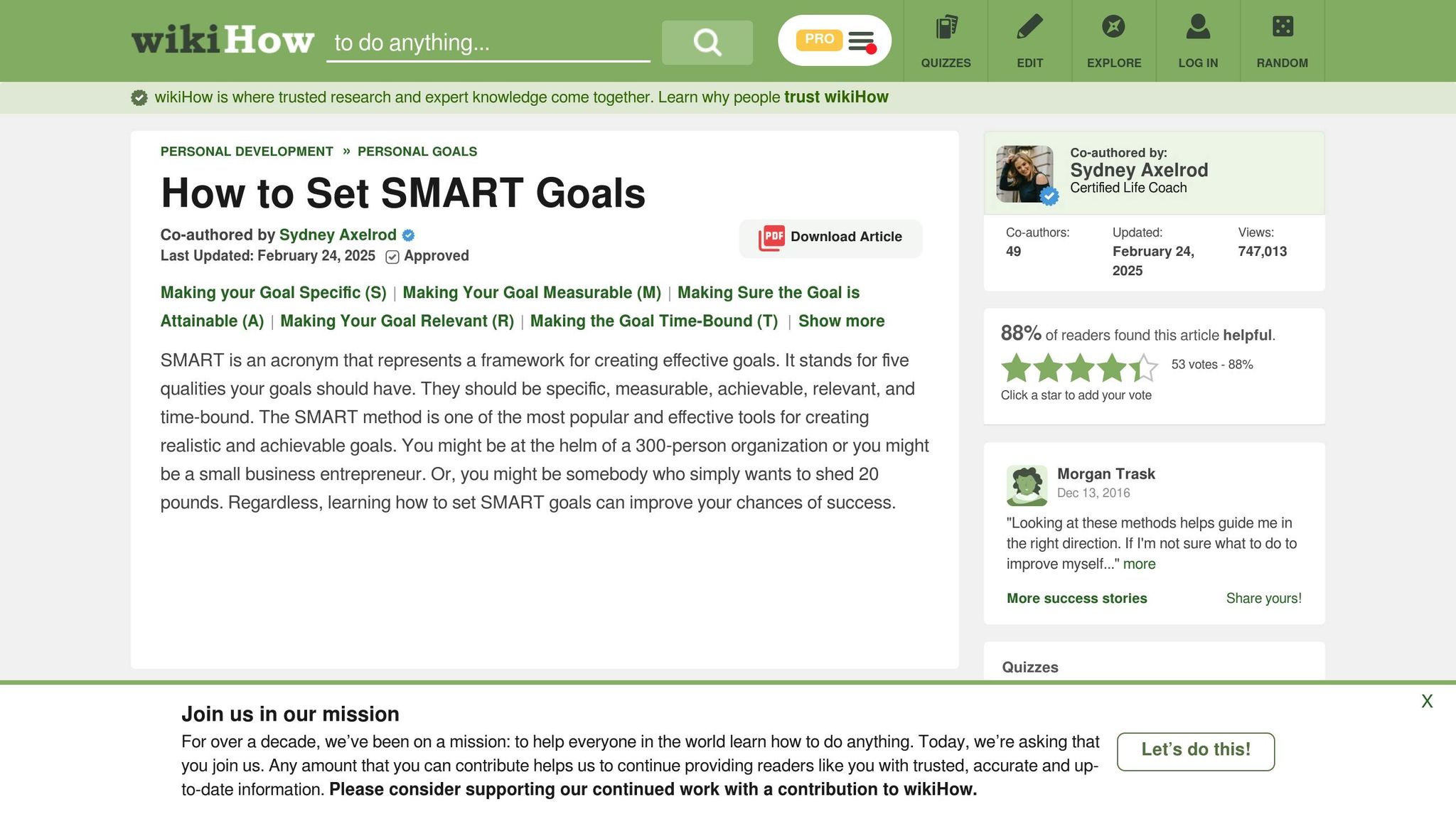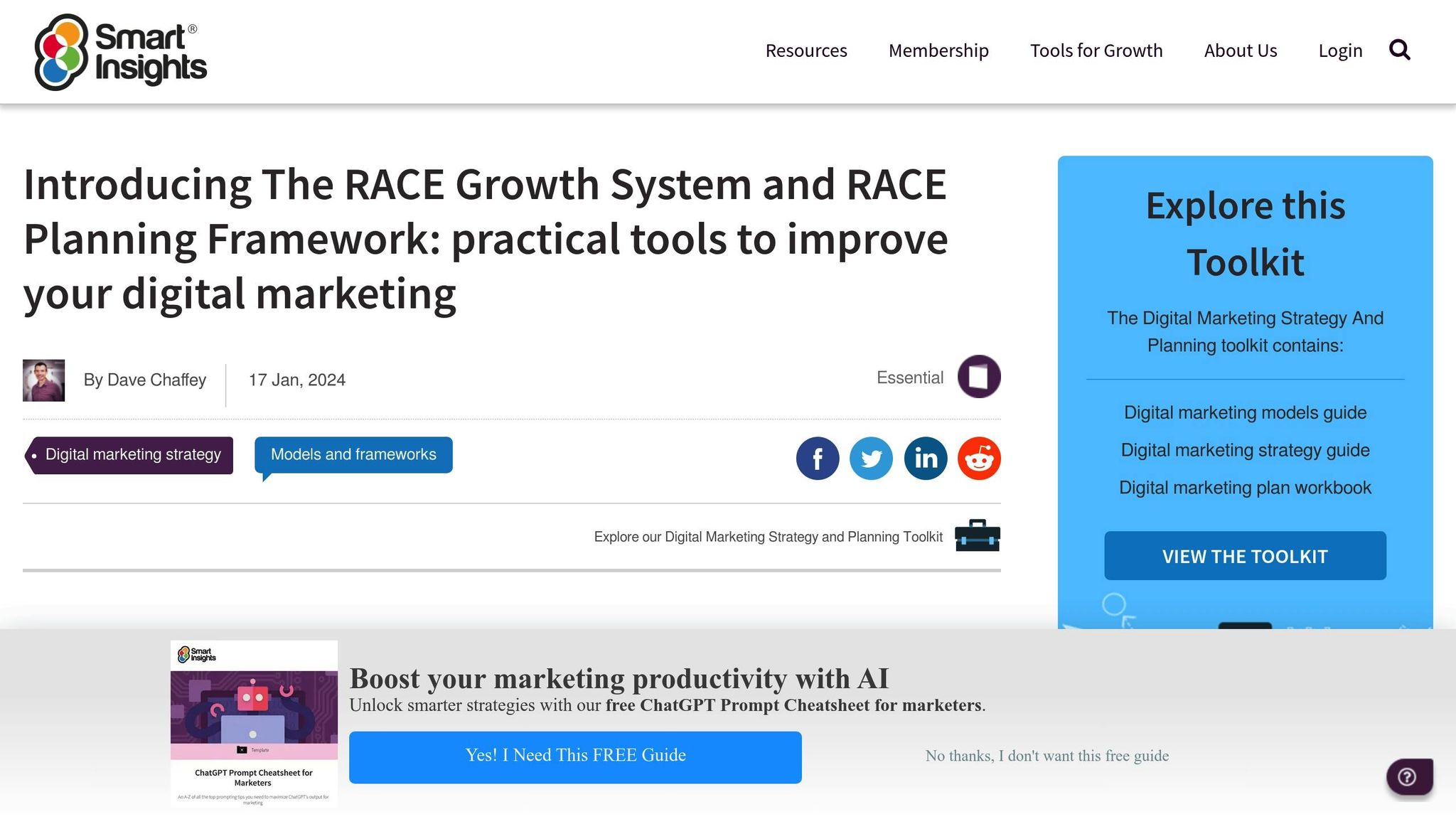Want to grow your business with technology? Start with a clear digital strategy.
This guide simplifies the process of creating a digital strategy that aligns with your business goals. Here’s what you’ll learn:
- Set SMART Goals: Define specific, measurable, and realistic targets.
- Use Proven Frameworks: Apply models like McKinsey 7S, RACE, and SWOT to plan effectively.
- Audit Your Technology: Identify inefficiencies and opportunities in infrastructure, performance, security, and costs.
- Build a Clear Action Plan: Break projects into steps, assign responsibilities, and track progress with KPIs.
A fractional CTO can save you money (up to $200,000 annually) while providing expert guidance to ensure your tech investments drive growth.
Key takeaway: A structured, goal-oriented digital strategy minimizes wasted resources and positions your business for success.
Mastering Digital Strategy
Key Digital Strategy Frameworks
Building an effective digital strategy often starts with the right frameworks. Below, we’ll break down four models that can help organizations shape successful strategies.
SMART Goals Method
The SMART framework is all about turning vague ambitions into clear, actionable goals. Here’s how it works:
- Specific: Clearly define what you want to achieve (e.g., "Increase mobile app user retention by 25%" instead of "Improve app performance").
- Measurable: Set metrics to track progress.
- Achievable: Ensure the goals are realistic given your resources.
- Relevant: Align objectives with your broader business goals.
- Time-bound: Assign deadlines and milestones for accountability.
Examples of SMART goals might include:
- Reducing system downtime to achieve 99.9% uptime within six months.
- Boosting digital customer engagement by 40% during Q3 2025.
- Implementing automated testing to cut QA time by 30% before year-end.
McKinsey 7S Model
The McKinsey 7S framework looks at seven interconnected factors that drive successful digital transformation. Here’s how each applies:
| Element | Application in Digital Strategy |
|---|---|
| Strategy | Align technology investments with business goals. |
| Structure | Create teams optimized for agile workflows. |
| Systems | Streamline processes with efficient digital tools. |
| Shared Values | Encourage a culture that prioritizes innovation. |
| Style | Support collaborative and adaptive leadership. |
| Staff | Build a workforce with strong digital expertise. |
| Skills | Focus on developing technical and strategic skills. |
RACE Planning Guide
RACE offers a customer-focused approach to digital strategy, broken into four stages:
1. Reach
- Define your audience segments.
- Choose the right digital channels for outreach.
- Build awareness with targeted content.
2. Act
- Craft engaging user experiences.
- Optimize all customer touchpoints.
- Track key user behavior metrics.
3. Convert
- Improve conversion rates through optimization.
- Simplify your digital sales processes.
- Measure ROI across all channels.
4. Engage
- Create loyalty programs to keep customers coming back.
- Develop strategies to improve retention.
- Monitor satisfaction metrics to refine your approach.
SWOT Analysis Steps
A SWOT analysis helps you understand your digital landscape by identifying strengths, weaknesses, opportunities, and threats:
Strengths:
- Assess your current technical capabilities.
- Evaluate the expertise of your digital teams.
- Review successful past initiatives.
Weaknesses:
- Pinpoint technology gaps.
- Identify inefficiencies in processes.
- Address resource limitations.
Opportunities:
- Explore new and emerging technologies.
- Stay ahead of market trends.
- Look for potential partnerships.
Threats:
- Consider cybersecurity vulnerabilities.
- Keep an eye on competitors.
- Stay informed about regulatory changes.
Digital Strategy Development Process
Building a strong digital strategy involves a step-by-step approach. Here’s how to create and execute a solid digital transformation plan.
Review Current Tech Status
Start with a detailed technology audit to pinpoint inefficiencies and uncover opportunities. Focus on these areas:
| Area | What to Evaluate |
|---|---|
| Infrastructure | Existing systems, tools, and platforms |
| Performance | System uptime, speed, and user experience |
| Security | Weak spots, compliance, and risks |
| Integration | Data flow, automation, and system links |
| Cost Analysis | Vendor expenses, maintenance, and ROI |
The results will help you set clear, measurable goals that align with your business needs.
Set Clear Goals
Define objectives that tie directly to your business priorities. Key steps include:
- Pinpointing measurable KPIs
- Creating scorecards to track progress
- Setting specific targets for each initiative
- Establishing milestones tied to a timeline
Create Action Plan
Draft a roadmap with clear steps and priorities. Break projects into manageable phases, assign responsibilities, set deadlines, and prepare for possible challenges.
Choose Tools and Teams
Pick the right technology and assemble skilled teams. Consider seeking guidance from a fractional CTO to deploy cost-efficient tools that align with your business goals.
Track and Improve Results
Use data to monitor progress and refine your strategy. Focus on:
- Regularly reviewing performance against KPIs
- Making decisions based on insights
- Encouraging feedback and collaboration
- Adapting plans quickly based on outcomes
sbb-itb-4abdf47
Digital Strategy Tips
Having a clear action plan is just the beginning. These tips help fine-tune your strategy by focusing on customer needs, improving team collaboration, and staying flexible when changes are needed.
Focus on Customer Needs
A strong digital strategy should revolve around what your customers want. Start by conducting a technology audit to pinpoint gaps between your tools and customer expectations. Map out every interaction your customers have with your business to spot areas that need improvement.
"A fractional CTO provides strategic leadership on a part-time basis, collaborating with your existing technology team or managing outsourced functions. They focus on aligning technology strategies with business objectives, ensuring tech projects, no matter how big or small, contribute directly to your business goals." – CTOx
Here’s how you can align technology with customer needs:
| Area of Focus | Actions | Benefits |
|---|---|---|
| User Experience | Run usability tests | Better customer satisfaction |
| Data Analytics | Use KPI scorecards | Smarter decision-making |
| Tech Infrastructure | Evaluate user experience | Improved system performance |
| Customer Feedback | Create feedback loops | Ongoing improvements |
Connect Teams Better
Getting different departments to work together is essential for executing your digital strategy. To improve collaboration, try these approaches:
- Hold Regular Strategy Sessions: Use these meetings to align priorities and review KPI scorecards.
- Set Up Clear Communication Channels: Use specific platforms for different types of communication to avoid confusion.
- Encourage Shared Accountability: Schedule regular check-ins led by tech leadership to ensure everyone stays on track with strategic goals.
These efforts build a solid foundation for the flexibility you’ll need to adapt quickly.
Use Quick-Change Methods
To keep your strategy agile, you need to monitor progress and adjust as needed. Here’s how:
- Track Performance: Use KPI scorecards to measure success and identify areas for improvement.
- Make Fast Decisions: Establish clear processes for evaluating and implementing changes quickly.
- Design Flexible Systems: Build infrastructure that can scale or adapt to meet new demands.
A fractional CTO can play a key role in keeping your strategy adaptable and effective.
Digital Strategy Examples
Structured digital strategy frameworks can lead to measurable transformations. Here are some examples showcasing the outcomes of applying such frameworks in real-world scenarios.
McKinsey 7S Framework in Action
A mid-sized manufacturing company faced challenges with uncoordinated processes. By applying the McKinsey 7S framework, they reorganized workflows, updated their systems, and improved team skills. This targeted approach helped them improve efficiency and focus their efforts on digital growth.
RACE Framework Driving Engagement
A regional retailer wanted to increase online interaction with its customers. By breaking their strategy into specific phases using the RACE framework, they improved their digital presence. This structured plan helped them connect with customers more effectively across various platforms.
Insights from SWOT Analysis
A technology services provider used a SWOT analysis to identify critical weaknesses in their digital operations. The findings helped them update their systems and improve their market position, resulting in greater efficiency and competitiveness.
Summary
Building an effective digital strategy means aligning your technology investments with your business goals. Using structured frameworks like McKinsey 7S, RACE, and SWOT analysis can set the stage for meaningful digital transformation. Regular audits and process updates help create a strong tech foundation to support these efforts.
"Unlike technology agencies that provide specific services on a project basis, a Fractional CTO offers strategic, visionary guidance and becomes a core part of your leadership team. This personalized approach ensures strategies are deeply integrated with your business objectives rather than being merely functional." – CTOx
This insight highlights the importance of having strategic tech leadership. A fractional CTO provides businesses with expert guidance at a monthly cost typically ranging between $3,000 and $15,000. This option offers ongoing leadership while being more cost-effective than hiring a full-time CTO.
Key elements for success include:
- Regular Assessment: Conduct audits to evaluate current systems.
- Data-Driven Decisions: Use KPI scorecards to shape your strategy.
- Strategic Alignment: Ensure tech initiatives directly support business goals.
- Continuous Refinement: Adjust plans based on performance results.
These steps lay out a clear path for implementing a successful digital strategy.









